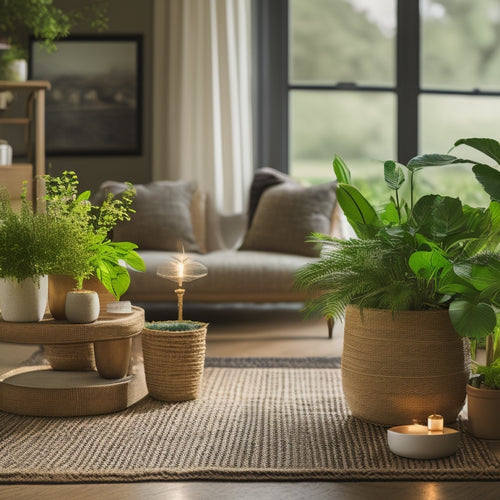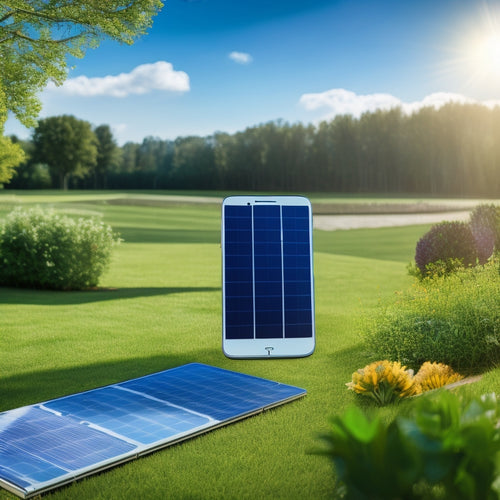
Upcycle Factory Finds: Chic Home Decor Guide
Share
As you scour thrift stores, flea markets, and salvage yards, you're on a mission to uncover unique, one-of-a-kind pieces that will give your home an industrial chic flair. You're drawn to the character and individuality that upcycled decor brings, and you're willing to get creative to achieve it. By repurposing discarded materials, like old pipes and machinery, you can create functional decor that's both eco-friendly and stylish. With a keen eye for detail and a hint of imagination, you can convert vintage factory finds into stunning pieces that tell a story of rebirth and renewal. Now, get ready to reveal the full potential of your finds.
Key Takeaways
- Scour estate sales, salvage yards, and flea markets for unique, one-of-a-kind factory finds that add character to your home decor.
- Transform industrial discards into functional decor, like pipes into pendant lights or machinery into metal sculptures, to reduce waste and add history.
- Revive vintage factory aesthetics by repurposing old machinery parts, distressed wood, or worn fabrics into chic decor pieces that evoke nostalgia.
- Upcycle factory finds affordably by sanding, refinishing, and repurposing to create industrial-chic decor that's both eco-friendly and budget-friendly.
- Infuse your space with industrial chic style by displaying upcycled factory finds as statement pieces, like metal sculptures or refurbished factory lamps.
Scouting for Hidden Gems
As you commence on the pursuit of creating a chic home, scouring for unique, one-of-a-kind pieces becomes an essential aspect of the process.
You'll uncover that thrift store shopping, flea market finds, and antique store treasures can add character to your space. By incorporating sustainable practices, such as utilizing solar-powered charging stations, you can reduce your carbon footprint and create an eco-friendly environment.
Estate sale revelations and salvage yard exploration can also yield unexpected gems. Community trade events and local artisan markets offer opportunities to find repurposed furniture and eco-friendly sourced items.
Transforming Industrial Discards
You'll be amazed at the potential hidden in discarded materials, where a rusty old pipe can become a unique lighting fixture or a vintage factory cart can be repurposed as a one-of-a-kind coffee table.
By embracing industrial relics, you're not only reducing waste but also infusing your space with a rich history and character. As you delve into this world of change, you'll uncover the beauty in forgotten treasures and the art of revamping the industrial past.
Furthermore, integrating sustainable design elements, such as solar-powered solutions, can enhance the eco-friendly aspect of upcycling, and strategically placing charging stations can improve the overall user experience.
Discarded Materials Revival
Into the domain of eco-friendly chic, discarded materials revival steps in, breathing new life into industrial discards once deemed worthless.
You're about to release your creativity, changing trash into treasure. This sustainable design approach not only reduces waste but also adds a touch of uniqueness to your home decor.
By adopting green initiatives, we can greatly lower our carbon footprint, supporting sustainability and promote environmentally responsible practices.
Repurpose old pallets into functional coffee tables or shelves, showcasing your eco-friendly spirit.
- Breathe new life into discarded metal drums, converting them into quirky side tables or planters.
- Upcycle vintage windows into stunning mirrors or decorative wall art, adding a touch of nostalgia to your space.
- Alter retired machinery parts into industrial-chic lighting fixtures, making a bold statement in your home.
Industrial Past Revamped
What secrets lie hidden in the relics of industrial past, waiting to be unearthed and reborn as stunning decorative pieces?
You'll uncover them by embracing the art of creative repurposing. Vintage aesthetics take center stage as you alter discarded machinery, gears, and pipes into unique conversation starters.
As you consider the environmental impact of your design choices, you may want to evaluate fleet energy needs and investigate eco-friendly alternatives to reduce your carbon footprint.
Imagine an old factory lamp refashioned as a chic pendant light, casting a warm glow over your dining area.
Or, envision a retired metal drum reborn as a remarkable coffee table, its industrial past now a reflection of your innovative spirit.
As you breathe new life into these relics, you'll create a space that's both nostalgic and avant-garde – a true reflection of your desire for freedom and self-expression.
Forgotten Treasures Reborn
Convert industrial discards into show-stopping centerpieces by reviving their inherent character. You'll be amazed at the unique stories these forgotten treasures tell.
Regular cleaning and maintenance practices, such as those mentioned in electrical connection maintenance, can guarantee the longevity of your upcycled pieces. Salvaged wood, once destined for the landfill, can become a stunning coffee table or wall art. Forgotten fabrics, too worn for clothing, can be repurposed into lively throw pillows or a one-of-a-kind rug.
- Change old machinery parts into industrial-chic lamps or pendant lights
- Upcycle vintage windows into mirrors or room dividers
- Turn abandoned pipes into quirky planters or bookshelves
- Revive discarded pallets into functional headboards or benches
Rustic Charm on a Budget
You can achieve rustic charm without breaking the bank by incorporating industrial chic decor into your space, such as repurposing old pallets or machinery parts as shelving units or coffee tables.
To add an extra layer of character, look for pieces with a distressed finish, which can be easily replicated with a little creativity and some DIY know-how.
Industrial Chic Decor
Several elements come together to create the distinctive look of industrial chic decor, which exudes rustic charm without breaking the bank.
You can easily achieve this aesthetic by incorporating metal accents, factory aesthetics, and other elements that evoke a sense of industrial heritage.
- Exposed brick or concrete walls that add a touch of ruggedness to your space
- Metal accents like galvanized pipes, aluminum beams, or steel furniture frames that bring in an edgy feel
- Factory-style lighting fixtures, such as metal shades or pendant lamps, that hang from the ceiling
- Reclaimed wood or repurposed materials that add warmth and character to your industrial chic space
Distressed Finish Magic
Industrial chic decor's emphasis on raw, unbridled aesthetics can sometimes come at a steep price.
But you can achieve that same rustic charm on a budget by embracing distressed finish magic. Scour flea markets, garage sales, or your grandmother's attic for distressed furniture with an aged patina.
Sand, strip, and refinish these finds to reveal their hidden beauty. You'll be amazed at how a little TLC can convert a discarded relic into a one-of-a-kind conversation piece.
With a distressed finish, you can add character to any room without breaking the bank. So, don't be afraid to get creative and give new life to old, discarded treasures.
Your wallet – and your sense of style – will thank you.
Breathing Life Into Metal
Energy seeps into the once-sterile domain of metal decor as designers skillfully awaken its innate elegance.
You, too, can breathe life into metal by embracing sustainable design principles and creative vision. Metal art, in particular, offers endless possibilities for alteration.
-
Repurpose old machinery parts into unique metal sculptures that double as functional decor.
-
Merge industrial metal frames with natural materials, like reclaimed wood or woven fibers, to create visually striking pieces.
-
Apply bold, lively colors to metal surfaces to inject a pop of personality into your space.
- Combine metal with other upcycled materials, like glass or fabric, to craft one-of-a-kind statement pieces that exude an eco-friendly chic vibe.
Reviving Vintage Factory Finds
In the forgotten corners of vintage factories, hidden gems await revelation, their rugged beauty and utilitarian charm begging to be unearthed.
You'll unearth vintage aesthetics that exude a sense of nostalgia, transporting you to an era of industrial grandeur.
As you dig through the remnants, you'll find factory nostalgia etched in every worn surface, every rusty hinge, and every faded label.
Reviving these finds requires a keen eye for detail and a willingness to reimagine their purpose.
You'll need to strip away the grime, sand down the rough edges, and apply a fresh coat of paint to bring out the beauty within.
With patience and creativity, you'll convert these discarded relics into unique pieces that tell a story of rebirth and renewal, infusing your home with a touch of industrial chic.
Turning Trash Into Treasures
Your keen eye for spotting potential in the discarded has led you to the bounty of trash, where the overlooked and underappreciated await change.
By embracing eco-friendly crafts and sustainable design, you're not only reducing waste but also creating unique pieces that tell a story.
As you explore the world of upcycling, you'll uncover that the most mundane items can be altered into functional works of art.
- Old pallets become rustic coffee tables or shelves
- Glass bottles are reborn as graceful vases or candle holders
- Vintage fabrics are repurposed into colorful throw pillows or wall hangings
- Discarded cardboard tubes are altered into quirky planters or pen holders
Upcycled Decor Inspiration Board
As you've converted discarded items into functional works of art, it's time to visualize your upcycled decor vision.
Create an inspiration board to organize your ideas and bring your creative recycling project to life. Gather images of upcycled art that resonate with your style, from rustic wood accents to industrial chic lighting fixtures.
Pin or clip them to a board, adding notes on the materials, colors, and textures that inspire you. This visual representation will help you identify patterns, themes, and cohesive elements, ensuring your upcycled decor flows seamlessly throughout your space.
With your inspiration board as a guide, you'll be able to make intentional design decisions, altering your space into a unique reflection of your personal style.
Frequently Asked Questions
Can I Upcycle Items From Non-Industrial Sources, Like Household Trash?
You can breathe new life into household trash, converting it into unique household treasures through creative reuse, freeing yourself from consumerism and embracing a more sustainable, eco-friendly lifestyle.
How Do I Ensure My Upcycled Decor Doesn't Look Too Diy?
You'll be surprised to know that 75% of consumers prefer sustainable products, and upcycling is a great way to contribute! To avoid the DIY look, you're careful to balance color coordination and texture mixing, ensuring a polished, high-end aesthetic that exudes sophistication and refinement.
Are There Any Safety Concerns When Working With Industrial Materials?
When working with industrial materials, you'll want to prioritize safety, as upcycling hazards like toxic chemicals, sharp edges, and heavy objects can be lurking; research the material's history, wear protective gear, and ventilate your workspace to guarantee a safe, liberated creative process.
Can I Combine Upcycled Pieces With New, Store-Bought Decor?
As you weave together eclectic threads, you'll find that combining upcycled pieces with store-bought decor is a harmonious marriage of contrasts, where rugged, industrial charm blends with sleek, modern sophistication, resulting in a unique upcycled aesthetic that's quintessentially you.
How Do I Price and Sell My Upcycled Creations?
When pricing your upcycled creations, you'll need to conduct a thorough cost analysis, factoring in materials, time, and overhead, then research the market to determine demand and competition, ensuring you set prices that are fair, yet profitable.
Related Posts
-

3 Best Solar-Powered Biodegradable Accessories for Your Home
You're taking a significant step towards a more sustainable lifestyle by incorporating solar-powered biodegradable ac...
-

7 Best Solar Panel Upkeep Apps for Homeowners
You can optimize your solar panel's energy output and efficiency by up to 20% with regular maintenance, which is wher...
-

10 Powerful Electric Mowers for Expansive Lawns
You're moving away from gas-powered mowers and exploring electric options for your expansive lawn. You'll find that h...


